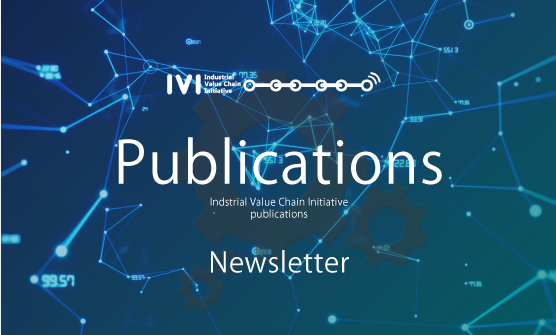New year greetings
A belated happy new year! 2016 is the memorial first year of “Connected Factory.” When IVI was launched in June last year, Industrie 4.0 in Germany and IIC in the US were mentioned everywhere by everybody, while from Japan, no comparable contribution was discussed in the global arena. Now, IVI is working on contributions out of Japan. Our approach to connected digital manufacturing pays tribute to the advancements that Japan has already made to date, while at the same time exploring where changes are needed moving forward, in a global picture. The biggest difference from last year is that we have a clearer picture about the way forward – we understand more about what should be changed and what should be kept. A new era is emerging, in which business is only possible in a connected fashion, and the best preparation is a bold move to open systems. But this needs to be done also in a way that competitive advantages can be encapsulated in order to protect and further strengthen unique assets of a company. It is also necessary to proceed with “loose standardization” which is inevitable to design the boundaries of the systems. The intelligent shop floor workers (gemba), which has been an important strength in Japanese manufacturing, can grow further with leveraging data collected with IoT and incorporating the power of software. It enables systems to be autonomous and distributed while aiming at the total optimization. Welcome to the world of Connected Manufacturing!
Yasuyuki Nishioka, President, IVI
Topics from activities of business scenario working groups
Currently, 19 business scenario working groups (WGs) are active in IVI. In each IVI newsletter, one business scenario working group will be featured. In this first newsletter, WG 108-2 “Autonomous MES integrating beyond corporate boundaries” is introduced. Mr Keisuke Oshima of Kojima Press, the facilitator of this group, was interviewed.  Mr Keisuke Oshima ■Please explain activities of the working group and expected outcome. At WG108-2, our activity is about how to share MES (Manufacturing Execution System) data among multiple companies. In the automotive and machine tool industry, at large companies, EDI and MES systems have been introduced for the production of management in the factory. However, these systems have different specifications for each company. They don’t share MES data from a factory / production across companies. Therefore, when e.g. a problem occurs at small and midsize suppliers, workers often have to collect information by telephone and e-mail. In our workgroup, we want to realize „connected manufacturing“. This means we are sharing a process among multiple plants to produce a product, and for this, we will share the respective MES data. We are establishing a standard reference model that allows change of production planning (production instruction MES) corresponding to quick alert at the time of trouble (facility monitoring MES). We expect that information sharing between factories/enterprises will greatly contribute to an increase of production efficiency and a reduction of lead time. ■ Please explain the aspiration of the reference model leveraging IoT. To prepare for processes divided over different companies,and to be able to deal quickly when trouble occurs, we need to establish a „loose standard model“ for the status of MES data and the factories in real time. There are four topics. a) Production instruction MES beyond the company: Timely production instructions from suppliers to ordering companies b) Facility monitoring MES beyond the company: Analysis and timely notification or more orders companies to order companies c) Golden flow with suppliers: WIN-WIN deal for ordering companies and suppliers (“IVI Smart Contract”) d) Robot utilization in the factory: Investigating the use of a general-purpose humanoid robot to help in information sharing First, we are performing a cleansing of the MES data to be shared for a) and b), this yields the required minimum of data to be shared. Additionally, we investigate whether one can not take advantage of the inexpensive general-purpose humanoid Softbank robot „Pepper“ as an information interface in the factory. Finally, we also plan to work out conditions of a trading agreement model for performing that new type of cooperation between companies. It has proven to be an advantage that in an early stage the WG members could share factory tours of the two companies involved (Kojima Press Kurozasa plant and Maruwa electrochemical headquarters plant) and therefore could share a concrete image. A high frequency of ad-hoc meetings (2-4 times per month) has helped to reduce the information gap between members and to ensure the progress. A certain challenge is if somebody can’t attend in ad-hoc meetings, for time and/or physical distance, as the participating locations are not close (Tokyo and Nagoya). ■Which further steps are you working on? Going forward, we are preparing demonstration experiments for topics “a) production instruction MES in excess of the company” and “b) facility monitoring MES beyond the enterprise.” In February 2016, we are going to carry out the first round of the demonstration experiment. In addition, for topic „d) robot utilization in the factory”, we are going to create a demonstration involving Pepper. We have 5 units at Kojima Press. We will develop our own application program for Pepper to support factory work. Pepper has been registered as an active member of WG108-2. He is also a member of the working group, playing a role as a presenter of IVI inside and outside. In the activity report at our major IVI event on March 10, our workgroup’s report is going to be presented by Pepper.
Mr Keisuke Oshima ■Please explain activities of the working group and expected outcome. At WG108-2, our activity is about how to share MES (Manufacturing Execution System) data among multiple companies. In the automotive and machine tool industry, at large companies, EDI and MES systems have been introduced for the production of management in the factory. However, these systems have different specifications for each company. They don’t share MES data from a factory / production across companies. Therefore, when e.g. a problem occurs at small and midsize suppliers, workers often have to collect information by telephone and e-mail. In our workgroup, we want to realize „connected manufacturing“. This means we are sharing a process among multiple plants to produce a product, and for this, we will share the respective MES data. We are establishing a standard reference model that allows change of production planning (production instruction MES) corresponding to quick alert at the time of trouble (facility monitoring MES). We expect that information sharing between factories/enterprises will greatly contribute to an increase of production efficiency and a reduction of lead time. ■ Please explain the aspiration of the reference model leveraging IoT. To prepare for processes divided over different companies,and to be able to deal quickly when trouble occurs, we need to establish a „loose standard model“ for the status of MES data and the factories in real time. There are four topics. a) Production instruction MES beyond the company: Timely production instructions from suppliers to ordering companies b) Facility monitoring MES beyond the company: Analysis and timely notification or more orders companies to order companies c) Golden flow with suppliers: WIN-WIN deal for ordering companies and suppliers (“IVI Smart Contract”) d) Robot utilization in the factory: Investigating the use of a general-purpose humanoid robot to help in information sharing First, we are performing a cleansing of the MES data to be shared for a) and b), this yields the required minimum of data to be shared. Additionally, we investigate whether one can not take advantage of the inexpensive general-purpose humanoid Softbank robot „Pepper“ as an information interface in the factory. Finally, we also plan to work out conditions of a trading agreement model for performing that new type of cooperation between companies. It has proven to be an advantage that in an early stage the WG members could share factory tours of the two companies involved (Kojima Press Kurozasa plant and Maruwa electrochemical headquarters plant) and therefore could share a concrete image. A high frequency of ad-hoc meetings (2-4 times per month) has helped to reduce the information gap between members and to ensure the progress. A certain challenge is if somebody can’t attend in ad-hoc meetings, for time and/or physical distance, as the participating locations are not close (Tokyo and Nagoya). ■Which further steps are you working on? Going forward, we are preparing demonstration experiments for topics “a) production instruction MES in excess of the company” and “b) facility monitoring MES beyond the enterprise.” In February 2016, we are going to carry out the first round of the demonstration experiment. In addition, for topic „d) robot utilization in the factory”, we are going to create a demonstration involving Pepper. We have 5 units at Kojima Press. We will develop our own application program for Pepper to support factory work. Pepper has been registered as an active member of WG108-2. He is also a member of the working group, playing a role as a presenter of IVI inside and outside. In the activity report at our major IVI event on March 10, our workgroup’s report is going to be presented by Pepper. 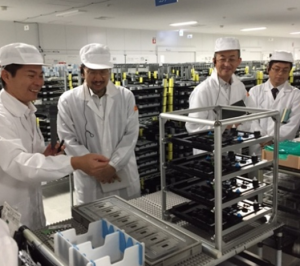
 Factory tour (October 2, 2015)
Factory tour (October 2, 2015)
Interviewer: Keiichiro Nabeno
Innovative ICT Seminar 2015 at Swedish Embassy in Tokyo
IVI has meanwhile drawn overseas attention, a number of requests for interviews and lectures from a variety of countries have come to IVI recently. IVI President Yasuyuki Nishioka was invited on stage to a panel discussion in Innovative ICT seminar 2015 held by the Swedish embassy in Japan on Nov 26, in the presence of Mikael Damberg, Swedish Minister for Enterprise and Innovation, and representatives of leading Swedish enterprises. It was also an opportunity for the Swedish participants interested in digital manufacturing to exchange opinions with IVI member companies. At the panel discussion, Prof Nishioka, President of IVI, Mr Kazuhiro Hosoi of Fujitsu Research Institute , and Ms Bodil Rosvall Jönsson of Skåne were on stage. Mr. Nishioka talked about the IVI setup and the use of IoT for manufacturing. 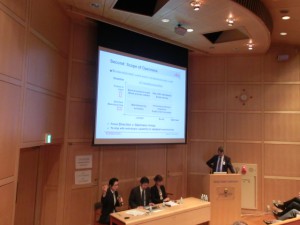 Panel discussion
Panel discussion 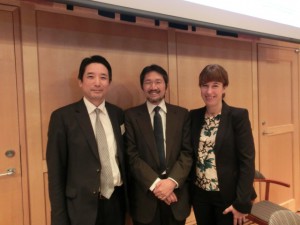 Mr Hosoi Kazuhiro (Fujitsu Research Institute), Prof Nishioka (IVI), Ms. Bodil Rosvall Jönsson (Skåne) The reception after the seminar began with greetings by Mikael Damberg, Swedish Minister for Enterprise and Innovation, and Magnus Robach, Swedish ambassador to Japan. Delicious Swedish food and drinks were also served. As Sweden has also set an emphasis on IoT manufacturing, IVI and its activities received great interest.
Mr Hosoi Kazuhiro (Fujitsu Research Institute), Prof Nishioka (IVI), Ms. Bodil Rosvall Jönsson (Skåne) The reception after the seminar began with greetings by Mikael Damberg, Swedish Minister for Enterprise and Innovation, and Magnus Robach, Swedish ambassador to Japan. Delicious Swedish food and drinks were also served. As Sweden has also set an emphasis on IoT manufacturing, IVI and its activities received great interest.  Swedish Minister Mikael Damberg speaking at the reception, 2nd from left: IVI President Yasuyuki Nishioka At the reception, Volvo and other Swedish enterprises also exchanged views with people of IVI member companies participating in the seminar.
Swedish Minister Mikael Damberg speaking at the reception, 2nd from left: IVI President Yasuyuki Nishioka At the reception, Volvo and other Swedish enterprises also exchanged views with people of IVI member companies participating in the seminar.
Hatsuko Kouroku
Visit of Dr Thomas Uslaender (Fraunhofer IOSB) to IVI
On November 16th, Dr Thomas Uslaender, head of department “Information Management and Production Control” at the Fraunhofer IOSB Institute at Karlsruhe, Germany, visited the head of the IVI, Prof. Nishioka, at Hosei University in Tokyo. In a very friendly atmosphere, both shared news on the status of Industrie 4.0 in Germany and the Industrial Value Chain Initiative in Japan. Topic was mainly the Reference Architecture Model Industry 4.0 and related standardization activities, as well as the IVI concept of a reference model based on a “loose standard”, an IVI keyword. Both explored possibilities of near-future collaborations around these matters. Outcomes of the relationship started by this fruitful discussion are expected to become visible in 2016. 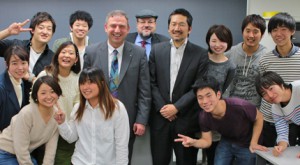 Dr Uslaender (centre left) also gave a lecture to students at Hosei University. Centre right: Prof Nishioka; centre rear: the author External link: “Information Management and Production Control” at the Fraunhofer IOSB
Dr Uslaender (centre left) also gave a lecture to students at Hosei University. Centre right: Prof Nishioka; centre rear: the author External link: “Information Management and Production Control” at the Fraunhofer IOSB
Axel H Saleck
From the Editors From now, on, we will publish this IVI newsletter regularily also in English, in response to an increasing interest of an international audience. We hope to serve your interest with this newsletter. 【IVI Publication Committee】 IVI Newsletter Editor’s Group http://www.iv-i.org/en/

